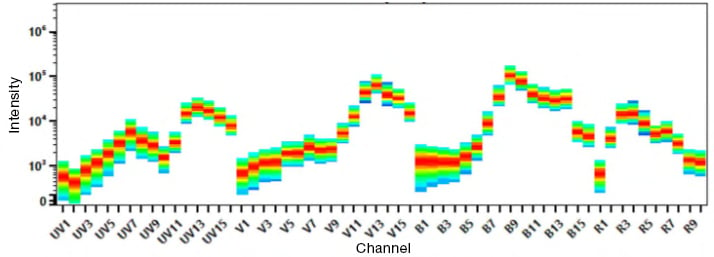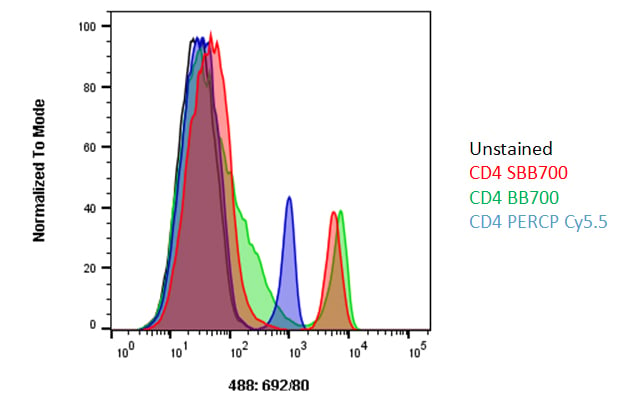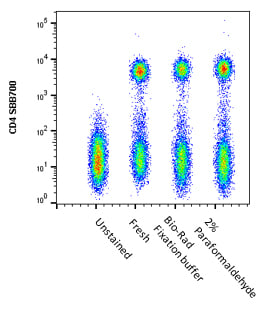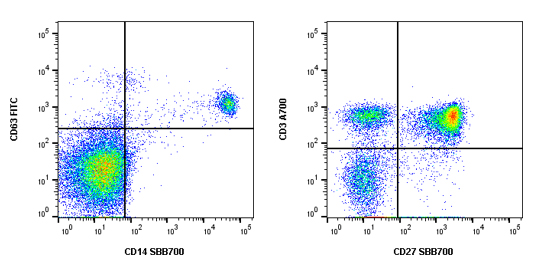StarBright Blue 700 Dye

- On This Page
- Overview
- Brightness
- Experimental compatibility and reproducibility
- StarBright Blue700 antibodies
- Resources for flow cytometry
Overview
Part of the new StarBright Dye range, StarBright Blue 700 Dye (SBB700) is a fluorescent nanoparticle which is the perfect alternative to PerCP, PerCP-Cy5.5, and BB700 in your flow cytometry experiments. Excitable by the blue 488 nm laser and emitting at 700 nm, it can be detected using the 692/80 filter on the ZE5 Cell Analyzer or similar filters in other instruments. SBB700 is not a tandem dye and exhibits reduced excitation from the 640 nm laser compared to fluorophores with similar excitation and emission (Figure 1).

Fig. 1. Excitation and emission spectra for SBB700. Maximal excitation is at 488 nm (dotted line) and maximal emission at 700 nm.
StarBright Blue 700 Dye is also suitable to be used in spectral flow cytometry, with its unique profile providing flexibility and an alternative choice for incorporation into new and existing flow cytometry panels (Figure 2).

Fig. 2. Complete dye signature for SBB700. The full emission spectrum of StarBright Blue 700 Dye showing the emission at all wavelengths. Data was collected on the Cytek Aurora Flow Cytometry System using SpectroFlo Software.
Brightness
SBB700 is an exceptionally bright dye, this can be up to 3 times brighter than PerCP-Cy5.5 and as bright or brighter than BB700 when tested on the ZE5 Cell Analyzer. This brightness, when combined with the reduced excitation by the 561 nm and 640 nm lasers, means this dye is an excellent alternative for inclusion in multicolor panels.

Fig. 3. Comparison of the brightness of StarBright Blue 700 (SBB700) with PerCP-Cy5.5 and BB700. Mouse blood stained with CD4 PerCP-Cy5.5 and CD4BB700 compared to CD4 SBB700 shows the increased stain index and brightness of the new StarBright Dye.
Experimental Compatibility and Reproducibility

Fig. 4. Comparison of the effect of fixation on StarBright Dye performance. Human peripheral blood was stained with CD4SBB700 (MCA1267SBB700) and then analyzed fresh or after fixation for 20 min with Fixation Buffer (BUF071) or 2% paraformaldehyde in PBS..
StarBright Blue 700 Dye does not require a special buffer when used in multicolor panels. It has been tested in multiple staining buffers, including special staining buffers for polymer dyes and most common staining buffers, with no drop in performance. This flexibility means it can be added into new or existing panels without a change to your experimental protocol. In addition, as SBB700 is not a tandem dye, it exhibits no photoinstability, is stable, and demonstrates minimal lot-to-lot variation. Antibodies conjugated to this dye can be fixed for analysis at a later date, with no reduction in fluorescence compared to freshly analyzed samples (Figure 4).
SBB700 is compatible with all common fluorophores such as organic fluorophores, protein fluorophores, polymer dyes, and other StarBright Dyes in multicolor panels, without the requirement for a special staining protocol. Protocols have been tested up to one hour at 4oC or room temperature with no significant alteration in the staining observed. Examples of staining can be seen in Figure 5.

Fig. 5. Examples of StarBright Blue 700 Dye staining. Human peripheral blood was stained with A, CD63FITC (MCA2142F) and CD14SBB700 (MCA1568SBB700) or B, CD3A700 (MCA463A700) and CD27SBB700 (MCA755SBB). All staining was done at 4oC for 30 min in PBS containing 1% BSA after blocking with 10% human serum. Cells were analyzed on the ZE5 Cell Analyzer.
StarBright Blue700 Antibodies
| Description | Target | Format | Clone | Applications | Citations | Code |
|---|
For more information on how the StarBright range can fit into your flow cytometry experiments, please take a look at our Starbright Dyes page.
For more information about fluorophores and immunophenotyping, refer to our flow cytometry resources.
Click on the links below to find out more in-depth information on each topic and view our popular flow cytometry basics guide.





